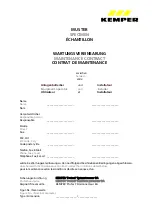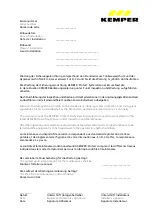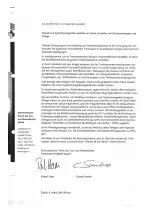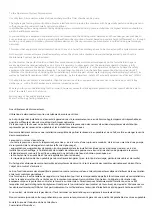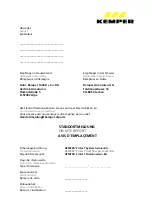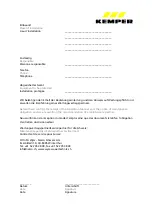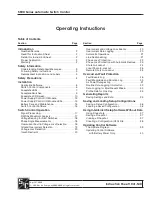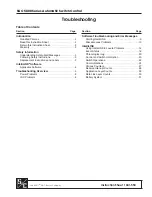
To the Operators of System Disconnectors
Use of System Disconnectors instead of free discharges with a float chamber and a pump
The highest goal setting at construction of water installations is to provide the consumer with hygienically perfect drinking water in
sufficient quantity under technically optimal conditions.
In distribution systems being represented by drinking water networks including home installations the highest attention should be
paid to backflow prevention.
In your building an equipment is operated which can contaminate the drinking water network and thus endanger people’s health.
Such an issue can occur e.g. at piping emptying (backflow or back suction of water based on geodetic height differences), or through
switching on of pump circulations, pressure increase devices, etc. (back pressures of polluted water into the drinking water supply
network).
This means that equipment or devices which do not have an internal free discharge have to be connected with a system disconnector.
As the system disconnectors are classified as safety valves, they have to be checked and maintained periodically, and thus the
Maintenance Contract has to be closed.
For that matter, the perfect function of backflow preventers and system disconnectors depends on the fact whether they are
maintained and checked periodically or not. Here it is necessary to stress again that the equipment operator (owner) is fully
responsible to maintain the perfect function of the equipment, and, therefore, it is the operator’s obligation to have the safety
equipment checked and maintained properly. The maintenance obligation on the backflow prevention devices is given by W3
„Directives for Construction of Drinking Water Installations“ which are part of local water supply regulations (Supply Contract), as
well as by foodstuffs regulation (LMV), and, in particular, by the federal law „Safety of Technical Equipment and Devices“ (STEG).
If the Maintenance Contract is undesirable, then the connection of such equipment or devices has to be carried out with a free
discharge, i.e. with a float chamber and a pressure increasing pump.
We ask you for your understanding for that issue; it, however, serves for drinking water protection so that we will also be able to
drink “tap water” also in the future.
Swiss Society of Gas and Water Branches
Water Technology Testing Laboratory
Aux utilisateurs de disconnecteurs,
Utilisation de disconnecteurs au lieu de systèmes à écoulement libre.
Le but principal des installations d´eau est d´approvisionner le consommateur en eau de boisson hygiéniquement irréprochable, en
quantité suffisante et dans des conditions techniques optimales.
C´est pourquoi il faut vouer une attention toute particulière à la prévention des retours d´eau dans les systèmes de distribution
représentés par les réseaux d´eau potable et les installations domestiques.
Dans votre bâtiment se trouve une installation susceptible de polluer le réseau d´eau potable et de ce fait, mettre en danger la santé
des consommateurs.
La cause d´un retour d´eau tel que
-chute de la pression « amont » (dépression), amenée p. ex. à la suite d´une rupture de conduite, de la mise en marche d´une pompe
de surpression, de la vidange des conduites (effet de siphonnage),
- augmentations momentanées de pression (contre-pression) dans les installations situées en aval du réseau, dues p. ex. à des
installations de chauffage, à l´inétanchéité des clapets de retenue de pompes ou erreur d´alimentation de pompes de réservoir,
est généralement connue. Elle est liée au danger d´une pollution de l´eau de boisson provoquée par
- le contact entre l´eau potable et l´eau d´exploitation (eau résiduaire)
- le risque de pollution de l´eau potable par des matières étrangères (p. ex. solution de lessivage, particules de sable et de rouille).
Du fait que les disconnecteurs sont assimilés à des systèmes de sécurité, ils sont soumis à des contrôles périodiques et doivent faire
l´objet d´un contrat d´entretien.
Le bon fonctionnement des dispositifs de protection contre les retours d´eau et des disconnecteurs dépend d´ailleurs de leur entretien
et de leurs contrôles périodiques.
Une fois de plus, il est nécessaire de rappeler ici à l´exploitant qu´il est seul responsable du parfait fonctionnement de ses installations,
et de le rendre ainsi attentif aux tâches qui lui incombent concernant les contrôles et l´entretien. L´obligation d´entretien des
équipements pour la protection contre les retours d´eau ressort des « Directives pour l´établissement d´installations d´eau » W3
lesquelles sont partie intégrante du règlement local pour la fourniture de l´eau (contrat de fourniture) ainsi que de l´Ordonnance sur
les denrées alimentaires (ODA) et tout particulièrement la Loi fédérale sur la sécurité d´installations et d´appareils techniques (LSIT).
Si un contrat d´entretien n´est pas désiré, il faut raccorder ces installations par un système à écoulement libre.
Nous vous remerçions de votre compréhension pour ces mesures qui servent à garantir une qualité irréprochable de votre eau potable.
Société Suisse de l´Industrie du Gaz et des Eaux
Commission d´Essais Eau
Summary of Contents for Protect BA Figure 366
Page 19: ......












